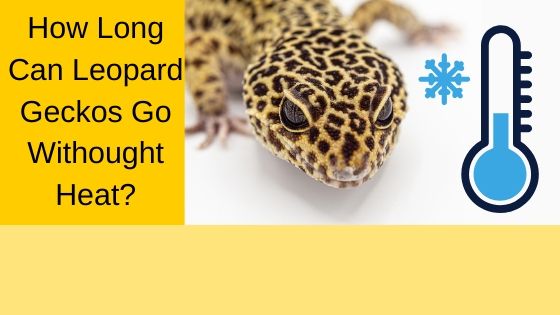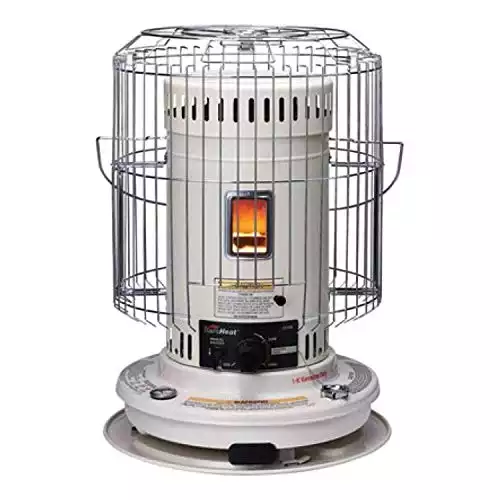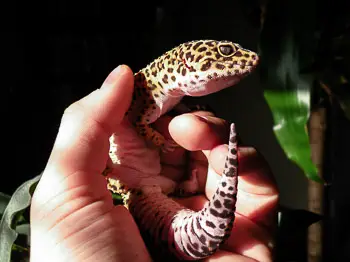In this post, we’ll talk a bit about your leopard gecko’s need for heat, and tell you how we made it through a five day power outage in the winter. As the temperature dropped, I was wondering myself how long can leopard geckos go without heat.
Reptiles are endothermic, or cold blooded. This means that lizards like your leopard gecko’s body heat are dependent upon their surrounding environment. Simply put: They need heat to survive.
Related Post: Best Leopard Gecko Heat Sources
This is why we recommend a warm side and a cool side of your gecko’s habitat; so they can move to the spent in the tank where they are most comfortable and self regulate their body temperature.
Brumation
Leopard geckos originate from hot dry desert areas, and are used to high temperatures. Even in the desert, it can get rather cool for reptiles during the winter months. Reptiles in the wild will sometimes slow down, or enter brumation. Brumation is the term for hibernation in cold blooded animals. In other words, mammals go through hibernation, and reptiles enter brumation.
This is normal, and your leopard gecko will naturally slow down if the temperature drops for an extended period of time. During brumation, a leopard gecko will survive off of the fat stored in its tail.
So, how long can leopard geckos go without heat? A healthy gecko may survive a month or so drawing from the reserves in its tail (not that we recommend putting this to the test.)
This assumes the temperature is still within a “normal” range that a leopard gecko would experience. If the temperatures start dropping below 60 degrees, your leopard gecko will have difficulty surviving for an extended period of time.
Extreme temperatures are a different story and your leopard gecko (or any reptile) will be at risk. What should you do in emergencies?
Be Prepared
Like any emergency preparation, the best thing is to have a plan.
If you know a storm is coming that may cause a power outage, there are some things you can do help your leopard gecko though with minimal discomfort.
- Stop feeding 24 hours prior to pending storms that may cause extended power outages. Leopard geckos absorb most of their heat through their bellies, and need this heat to properly digest their food. Without heat, the food will just sit and not move through their system. It’s better that your leopard gecko go without food for a few days than have a bellyful of food it cannot properly digest.
- If you do lose power, cover the tanks with a towel or blanket to help retain the heat. Remember your gecko still needs to breathe, so the goal here is to prevent heat loss, not make it air tight.
- Plan alternate heat sources that do not require electricity. We’ll share a number of options below.

Our Experience
The Blizzard
Our leopard gecko, Dude, and I went through blizzard that caused a power outage. We were without power for 5 days. In the winter. Yes, it was cold. We knew the storm was coming, but like most Nor’easters, no one quite knows when it’s going to be a big one until it dumps piles of snow at your door.
This one took out power lines leaving large parts of the population in the dark (and cold.) The first day or so was fine. The storm passed, the roads were cleared, and everyone was just dealing with the aftermath. And the power company was scrambling to restore service to thousands.
It got a bit chilly, but hey – the power will com back on at any moment, right? When the power didn’t come back on after two days, my wife headed to the in-laws who lived an hour away, and had power. I stayed behind and hung blankets in doorways to cut down on the space I was trying to keep warm (which included the leopard gecko tank.)
I lit a bunch of candles and fired up a borrowed kerosene heater. I’d let the heater run for a while and get a section of the house nice and toasty, then shut it off (and move the heater to other areas of the house in hopes of keeping the place warm enough to prevent frozen pipes.)
Head for the Heat – Take your gecko someplace warm
It was fun for a while, braving the storm and reading by lantern light. After another day and a half, my concern for Dude was growing. In retrospect, it probably would have been fine. Retrospect didn’t know when the power would come back on. I caved and packed up Dude in a plastic container and headed to join my wife at the in-laws.
Once we were back in a heated house, I knew we were going to be fine. Since I hadn’t brought the gecko enclosure, I improvised a heat source by filling a sock with rice and microwaving it, placing it under a folded up towel in his container. Every so often I’d need to reheat the sock (warm – not hot.) Early the next morning, the power (and heat) was restored, and we returned home.
Alternate Heat Sources
Heat Packs
A heat pack like UniHeat Shipping Warmers can be used for a long lasting temporary heat source. Some companies that ship reptiles (or plants, fish, etc.) will use these.
Heat packs like these last from 30 to 72 hours, and should be enough to get your gecko through an emergency.
Even though these are made for shipping reptiles, you still want to be careful that your pet doesn’t come in direct contact with the heat pad to avoid burns. Make sure there is some insulation between your gecko and the heat pack.

Power Stations & Generators
After making it through an extended outage, I wound up getting a portable power station. There are a number on the market to choose from, and something like the Goal Zero Yeti 400 balances price, size, and power. Unlike generators, units like this are not gas powered, and are safe to use indoors. Just make sure to keep it charged so it’s ready when you need it. It’s portable and can keep your gadgets powered if you’re going camping etc.

If you want to take preparedness to the next level, you can use solar panels to recharge the power station. You’ll need an inverter to connect the solar panels, like this one on Amazon: Solar to 8mm Adapter Cable.
There are kits available that include foldable solar panels and inverters like this one: Rockpals 100W Foldable Solar Panel Charger.
Heaters
Kerosene heaters have had their heyday and aren’t the best for prolonged indoor use. That said, the heater did a great job of keeping the house warm in the absence of electric or heat. One of these used in short bursts was enough to get through a few days.
The best endorsement? After we returned the one we borrowed, we wound up buying one. For next time – just in case.

Make sure you have everything you need for your leopard gecko habitat and visit our HABITAT SETUP Page.








